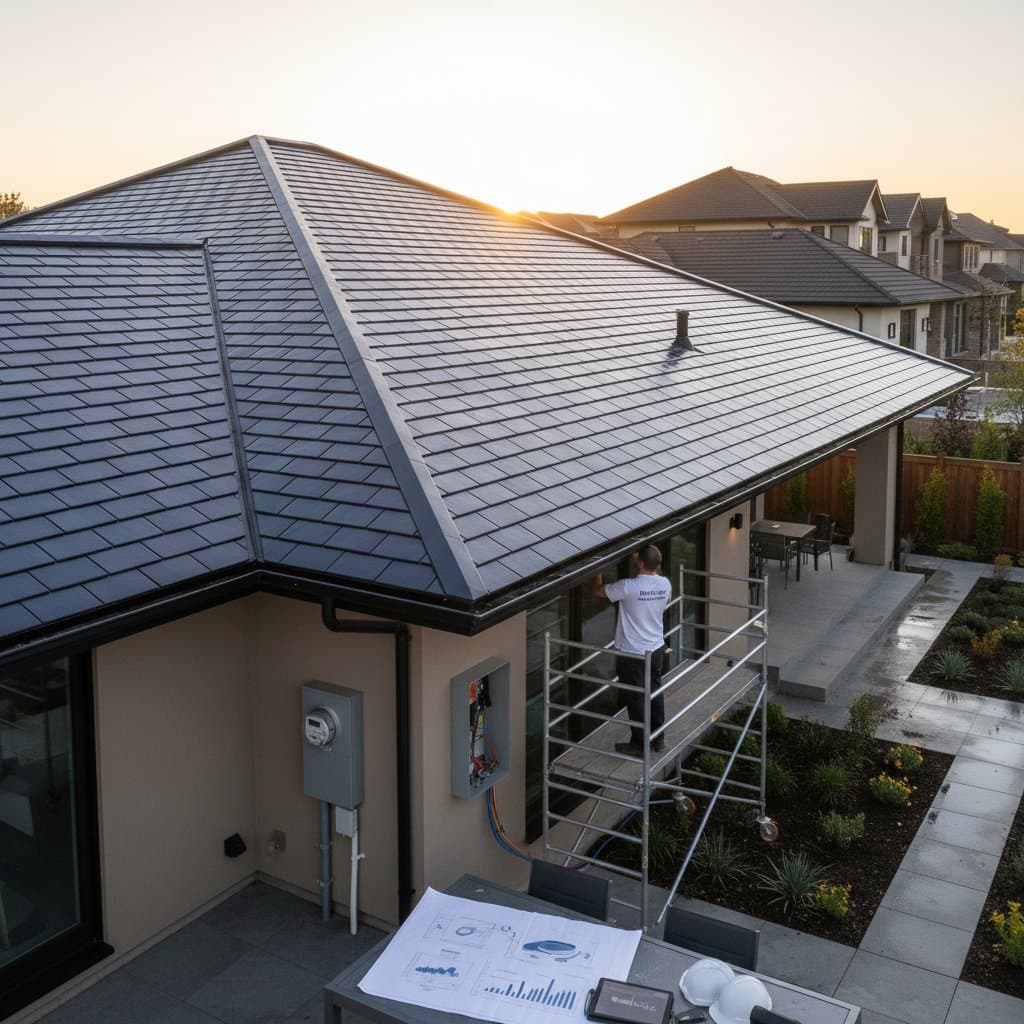2025 Solar Roof Costs: Requirements You Cannot Ignore
Quick Take
- Full solar roof systems typically cost $40,000 to $80,000 for average homes.
- Factors such as roof condition, pitch, and electrical upgrades significantly influence the total expense.
- Replacing the roof before installation often saves thousands in future costs.
Pros and Cons
Pros
- The design provides a seamless appearance that integrates with the existing roofline.
- It generates renewable electricity without requiring roof penetrations.
- Property values may increase, and energy bills decrease over time.
- Eligibility exists for federal and local tax incentives.
Cons
- Upfront costs exceed those of traditional solar panels.
- Installation requires more time due to the integration with roofing materials.
- Repairs become complex if individual sections malfunction.
- Availability of experienced contractors varies by region.
Step-by-Step: Preparing for a Solar Roof
Preparation involves specific tools and materials: a ladder, tape measure, roofing inspection camera, flashlight, electrical panel key, and notebook for recording measurements.
The process takes 2 to 4 hours for inspection and initial preparation.
Difficulty level: Moderate.
-
Inspect Roof Structure
Examine the roof for sagging areas, soft spots, or damaged decking. The structure must bear the weight of solar tiles and mounting hardware. Consult a structural engineer if weaknesses appear. -
Check Roof Pitch and Orientation
Measure the slope and direction with a compass app or inclinometer. Optimal angles fall between 25 and 40 degrees, facing south. Steep pitches or shaded areas diminish energy output and overall system value. -
Evaluate Electrical System
Locate the main breaker panel and assess available capacity. Full or outdated panels necessitate upgrades. Solar installations frequently demand a 200-amp service panel to handle the load. -
Review Local Rules and Permits
Municipalities often require structural and electrical permits for solar roofs. Additional standards may include fire ratings or minimum distances from roof edges. Reach out to the local building department prior to contracting. -
Get Multiple Quotes
Obtain itemized estimates from at least three certified installers. Inquire about panel efficiency, warranty terms, removal fees, and projected energy production. -
Plan for Roof Replacement if Needed
If the roof has fewer than ten years of remaining life, replace it before solar installation. Postponing this step leads to higher reinstallation expenses later. -
Inspect and Approve Design
Scrutinize provided renderings and electrical layouts. Verify that inverter placement, conduit paths, and visual elements align with your expectations. -
Schedule Installation
Projects generally span one to three weeks, depending on weather conditions, roof dimensions, and crew schedules. -
Inspect After Completion
Confirm that all tiles align flush, flashing remains secure, and wiring includes proper labels. Obtain documentation for system specifications and warranty activation. -
Activate and Monitor
After utility approval for interconnection, use the installer's app to track output. Review daily and monthly data to identify potential issues promptly.
DIY vs Professional Installation
When DIY Is Appropriate
- Limit efforts to basic roof inspections or debris removal.
- Ensure prior experience with safe roof and ladder work.
- Perform electrical capacity checks without altering wiring.
When to Hire a Professional
- For all installation or wiring of solar components.
- When upgrading electrical panels or roof decking.
- During applications for building or utility permits.
Key Differences in Professional Approach
Certified installers conduct precise load calculations, develop circuit designs, and apply seals to meet building codes. They manage inspections, handle warranty processes, and facilitate utility connections. Such expertise safeguards warranties and maintains property insurance validity.
Alternatives to Full Solar Roofs
Traditional Roof with Mounted Panels
This option suits tighter budgets or recently replaced roofs. Repairs prove simpler, and costs per watt remain lower. Drawbacks include visible panels and necessary roof penetrations.
Solar Shingles
These smaller integrated panels mimic asphalt shingles for blended coverage. They work well for partial installations or targeted roof sections. Efficiency is marginally lower, though matching existing materials simplifies aesthetics.
Ground-Mounted Solar System
Ideal for shaded or weak roofs, this setup allows easier cleaning and expansions. It requires yard space and extended wiring, however.
Checklist: Confirmations Before Signing a Contract
- Roof structure and decking condition verified as sound.
- Electrical panel capacity assessed, with upgrade plans if required.
- Shading analysis performed across all roof sections.
- Local permits and inspection requirements confirmed.
- At least three written quotes obtained and evaluated.
- Warranty specifics for roof and solar components clarified.
- Utility interconnection procedures outlined.
- Maintenance strategy and cleaning access defined.
Implementing Your Solar Roof Plan
A solar roof delivers sustainable energy and enhances curb appeal, yet thorough preparation determines its success. Assess roof integrity, verify electrical compatibility, and allocate funds for comprehensive integration. Select installers through diligent comparisons and scrutinize contract details. Post-installation, maintain cleanliness and track performance to maximize returns on your investment.



